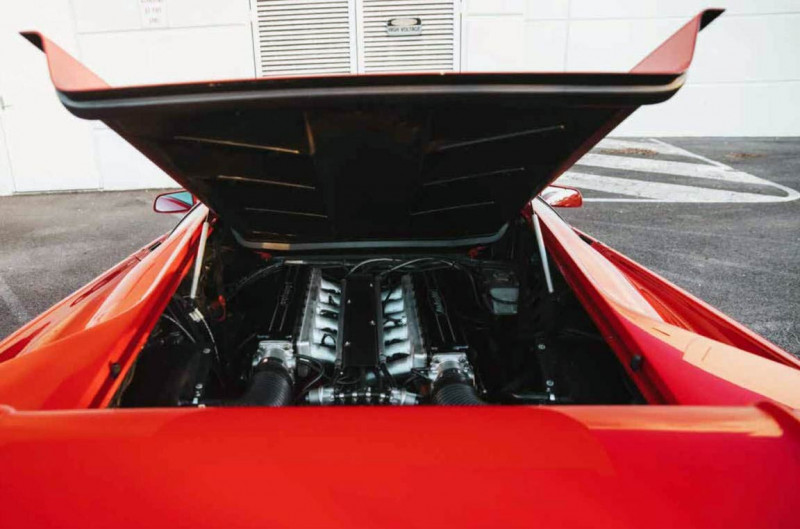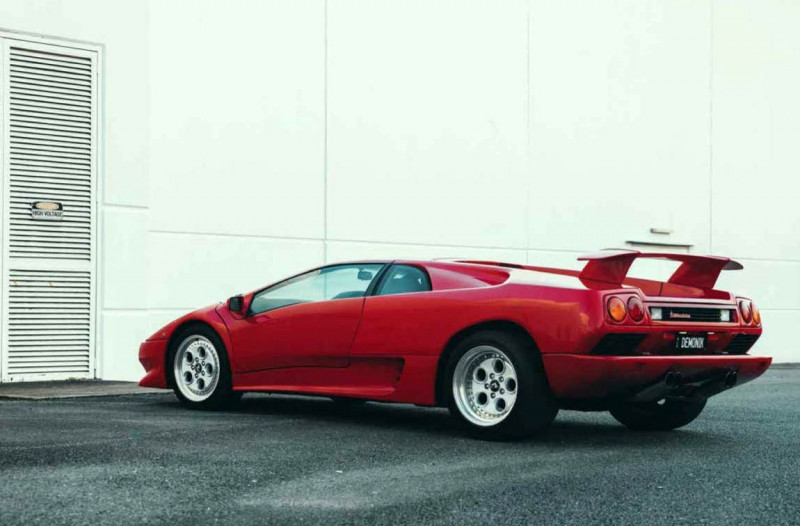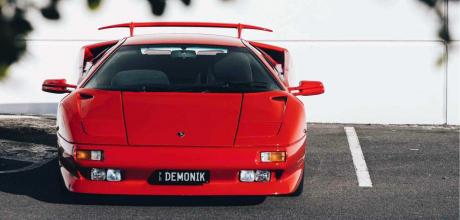1991 Lamborghini Diablo 5.7 V12
Successor to the legendary Countach really was a supercar with a devilish side. Photos Nathan Duff.
Overrun
MODERN CLASSIC
People claim, for not entirely sane reasons, that Ferraris should only ever be red, but we would argue that statement rings truer for the original Lamborghini Diablo. Sant’Agata’s supercar may have also been offered in yellow, white, silver, blue or black, but if ever a colour was perfectly matched to a nameplate, it’s ‘Diablo Rosso’.

Unveiled in January 1990, the Diablo kicked off a great decade for outlandish supercars. Four years in development, Lamborghini named its long-awaited Countach replacement after a famous Spanish fighting bull – continuing a tradition that began with the ’66 Miura – though ‘Diablo’ is also Spanish for ‘devil’, which could’ve been a metaphor for this car’s journey from Italian-styled prototype to American-restyled production car. As a successor to the legendary Miura (1966-1973) and Countach (1974-1990), it’s impossible to overstate the expectation on project P132 (the Diablo’s codename). By the time the era-defining Countach LP5000 ‘Quattrovalvole’ appeared in 1985, Lamborghini’s razor-edged supercar had been dominating petrolhead’s fantasies for more than a decade and management knew its replacement needed to be something special. But when company president Emile Novaro reiterated the Diablo’s original brief to our very own Peter Robinson in a January 1990 interview, he said it was simply “to create a Countach successor.”

“It wasn’t necessary to add any more,” said Novaro. “Everyone here [at Sant’Agata] knows what the Countach meant – and still means – to Lamborghini. We had to improve its performance, safety, comfort, visibility, access and emissions. There wasn’t any sense in giving precise targets: we simply had to do our best.”
To achieve this monumental task, Lamborghini began by hiring a new technical director, Luigi Marmiroli – a former Ferrari and Alfa Romeo F1 engineer – for the sole purpose of making P132 a production reality. After engineering the Countach’s swansong, the Anniversary, Marmiroli’s team began work in early 1986 on the preliminary technical layout of the Diablo. It would be a development of the Countach concept – spaceframe chassis, mid-mounted longitudinal V12, trademark ‘scissor’ doors – but larger and more sophisticated to accommodate modern safety legislation as well as the expanding size of the average customer.
Several designers and design houses were asked to contribute sketches, though Marcello Gandini – he of both Miura and Countach fame – submitted the winning styling proposal. A full-scale model of Gandini’s design was presented to Lamborghini management in June ’86, and subsequently given a green light.
By early ’1987, the first prototype was lapping Italy’s Nardo speed bowl, powered by a heavily modified version of the 5.2-litre V12 from the Countach QV and Anniversary. With increased outputs powering a much more aerodynamic shape (0.31 for the final production Diablo versus around 0.40 for the Countach), P132 was considerably faster than its predecessor. But Lamborghini wanted more.
Ferrari’s limited-production 1987 F40 had just reached a top speed benchmark of 323km/h – blitzing the Countach Anniversary’s 295km/h – so if there was an actual target during Diablo’s development, even an informal one, it was surely ‘in excess of F40’. Marmiroli’s engineering team abandoned the uprated 5.2 and set about developing an extensively new 5.7-litre version of Lamborghini’s 60-degree V12, not only with standard fuel injection (most Countach QVs still ran Weber carburettors) but with the added handicap of catalytic converters for its intended unleaded-petrol diet.
Meanwhile, back at Sant’Agata Bolognese, big things were happening. In April 1987 Chrysler bought Lamborghini, bringing with it the promise of both funds and creative freedom. But the reality wasn’t quite so clear-cut for the Italians. Chrysler insisted on modifications to Gandini’s outlandish design, which he reluctantly agreed to, but the Americans still weren’t content. Under the direction of Tom Gale, Chrysler’s vice president for design, the Diablo’s production form would be completed in Detroit – retaining the general flavour and proportion of Gandini’s original but smoothing out the edges, as well as altering the rear panels around the air intakes.
Following Chrysler’s meddling, the second Diablo prototype wouldn’t be spotted until mid-’89 at the Imola racetrack – revealing the extent of Detroit’s styling alterations, though the bumpers and louvred engine cover would be altered again before production. Still, when the showroom-ready Diablo appeared in January ’90, a quietly proud ‘Disegno Marcello Gandini’ badge glinted ahead of Gandini’s trademark (albeit smoothly contoured) rear wheelarch shape. Much like the Countach before it, the Diablo’s overall design was born relatively clean … and, perhaps controversially, looks best in its most unadorned form, as pictured here (with optional rear spoiler). Time has been unexpectedly kind to the visual purity of the original Diablo – particularly from its still-breathtaking rear end, which accommodates enormous 335/35R17 Pirellis with a devilish balance of subtle yet sinister. And the Diablo’s five-hole, exposed-nut 17-inch wheels are the perfect garnish. Inspired by the 25th Anniversary Countach’s similar-design wheels, they’re way cooler than the smoother, more generic rim designs of later Diablos.
As you’d rightfully expect of a supercar that cost $695,000 when new (it launched here in September ’91), there’s plenty of cuttingedge technology in the Diablo’s construction. Like the Countach, its core is a welded steel spaceframe, though with square tubing (instead of circular) to make it easier to attach components to. The cockpit is high-strength steel, the quarter panels and doors light alloy, the centre tunnel carbonfibre, and the bumpers, engine cover and bonnet made from a composite of carbonfibre and fibreglass.
Despite all its diet tricks, the Diablo is not a light car. Lamborghini had hoped to match the Countach’s 1490kg kerb weight, but the Diablo finished development at 1650kg. Technical director Marmiroli blamed the marketing department’s desire to include extravagances like climate-control air-con, power windows that could retract completely (unlike a Countach!), and a top-shelf Alpine sound system, though engineering the Diablo from the outset to also offer all-wheel drive (which debuted in ’93 in the Diablo VT) definitely added to its mass.
It’s also a bigger supercar than the Countach. A huge 150mm wheelbase stretch (to 2650mm) increased passenger space for taller folk and massively improved entry and egress, though by accommodating the VT version’s front driveshaft s, the increase in actual footwell room – a well-known Countach failing – was a scant 12mm. But the Diablo’s most dramatic improvements all centred around its beating heart – that heroic, naturally aspirated 5.7-litre V12. With a larger bore and stroke, and an increased 10.0:1 compression ratio, as well as Lamborghini’s own sequential multi-point fuel-injection system, the detoxed Diablo’s 5.7 soared far beyond the Countach’s 5.2.
Power jumped from 339kW at 7000rpm to 362kW at the same revs, while torque increased from 510 to 580Nm, again at a steep 5200rpm. But unlike the rather peaky Countach, the Diablo’s V12 is already cranking out 280Nm at 2000rpm, gifting it a flexibility unheard of in its predecessor. And yet its redline stands tall at an intoxicating 7600rpm, all of which is useable, and its induction sound is a recipe of many rich flavours, all of them wonderful.
Extend the Diablo to its rev ceiling and it’s little wonder the 0-100km/h claim is a spectacular (for the time) 4.1 seconds. First gear runs to 105km/h at redline, and the numbers expand exponentially from there. Second achieves 158km/h, third 214, fourth 272, and fifth, well, arrivederci F40. The Diablo’s 325km/h top speed, certified at the Nardo speed bowl and achieved right on peak power (7000rpm), was matched by a 0-200km/h time of 20.7sec – 0.3sec faster than the F40. Contemporary road tests praised its poise at well beyond 200km/h, the stability of its chassis, the surety of its manual steering (power assistance wasn’t available until 1993), and even its ride – at least compared to a Countach.
Looking at it today, it’s easy to forget that the Diablo’s path to life was an obstacle-strewn tough-mudder course. Yet there’s still so much right about the car that it deserves its position towards the upper end of the supercar echelon. It had the unenviable task of replacing the flawed-but- fabulous Countach, which was a poster child of its time. And that’s something the Diablo never really enjoyed.
But the original Diablo has aged rather gracefully. Lamborghini made many attempts at making it faster, smoother, grippier, more outlandish and more modern, in a perpetual push to produce the best Diablo it could. Yet there’s an almost subtle purity about the original, irrespective of Chrysler’s alterations, that still makes the Diablo dream material.
Above: Engineering Diablo for AWD meant cabin space wasn’t as commodious as the 2650mm wheelbase suggests. Shift action of the gated five-speed ’box matched the steering: manly.
FAST FACTS TIME ON ITS SIDE
The Diablo’s interior was also styled in Detroit (by Bill Dayton, on contract to Chrysler), though to the Yanks’ credit, the original Diablo’s relatively straightforward cabin architecture has aged much better than the overwrought 1998 restyle, despite being let down by some of its details. These include scattered instruments hidden by the small steering wheel (later fixed), cheap column stalks, and a hugely expensive optional Breguet clock that required manual winding…
LOOSE CHANGE
Diablo morphed into a number of iterations over its lifespan. First there was the AWD VT (’93), the SE30 (’93), the 380kW SV (’95) and VT roadster (’95). A ’98 facelift (with fixed headlamps from the Z32 Nissan 300ZX) brought 394kW for (now entry-level) SV, VT and VT roadster, plus a 429kW 6.0-litre GT. Then new owner Audi did a final, ultra-slick makeover in 2000, creating the 6.0 VT.
“Redline is at 7600rpm, all of which is useable; its induction sound is a recipe of many rich flavours, all of them wonderful”
Overrun
MODERN CLASSIC Model 1991 Lamborghini Diablo
Engine 5707cc V12 (60°), dohc, 48v
Max power 362kW @ 7000rpm
Max torque 580Nm @ 5200rpm
Transmission 5-speed manual
Weight 1650kg
0-100km/h 4.1sec (claimed)
Economy 22.9L/100km (combined)
Price (now) $400-500,000
Chrysler insisted on modifications to Gandini’s outlandish design, which he reluctantly agreed to, but the Americans still weren’t content
THE GOOD
Much more practical than a Countach; ferocious V12 performance; outstanding driveability; supreme high-speed poise; megatough rear styling
THE BAD
Cramped pedals; heavy steering without power assistance; ferocious fuel consumption; hidden instruments; no ABS (until ’99!)
FACT CHECK
P132 DIABLO’S CODENAME
2884 TOTAL NUMBER PRODUCED BETWEEN 1990 AND 2001
41/59 FRONT/ REAR WEIGHT DISTRIBUTION OF RWD DIABLO
325 ‘HOMOLOGATED’ TOP SPEED (IN KM/H) ON ITALY’S NARDO BOWL
0.31 DRAG COEFFICIENT OF 1990 DIABLO


